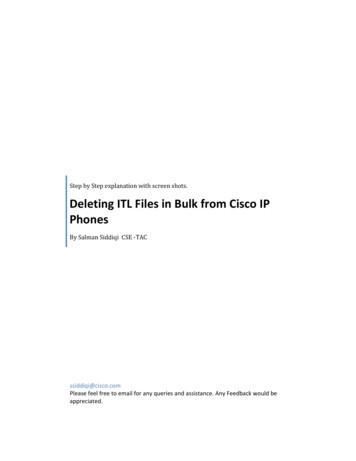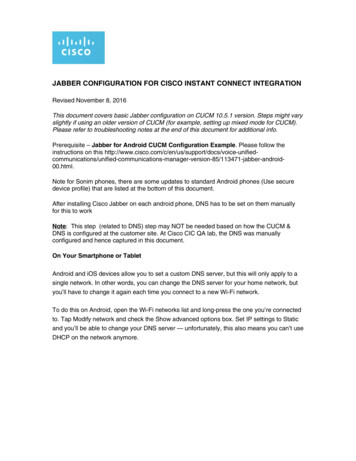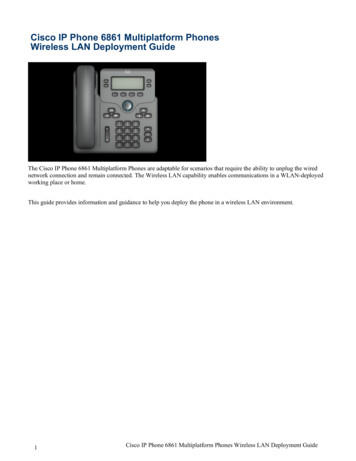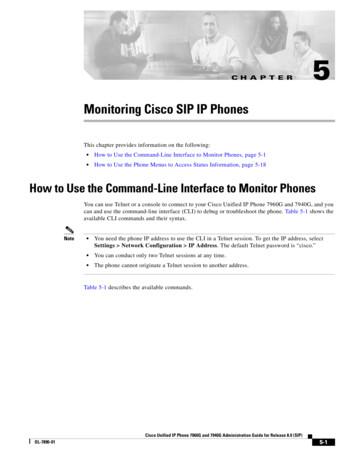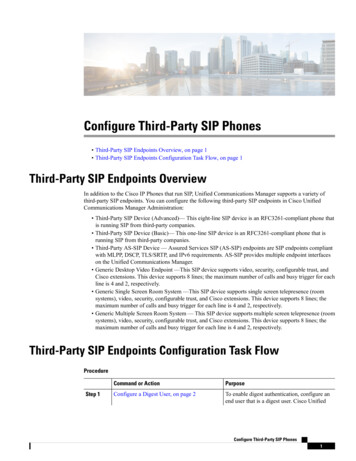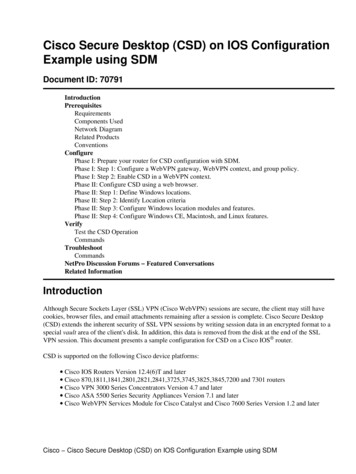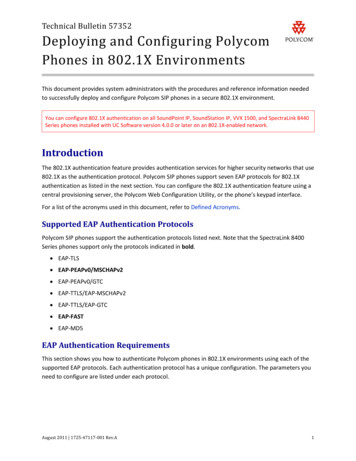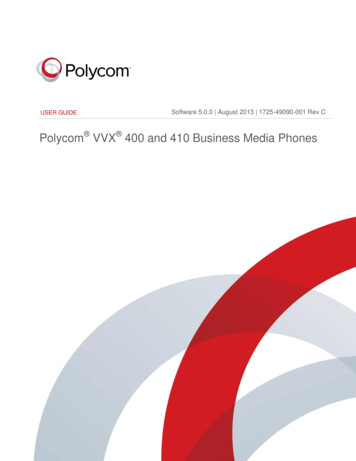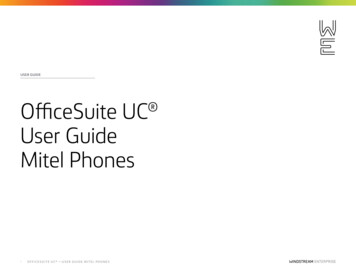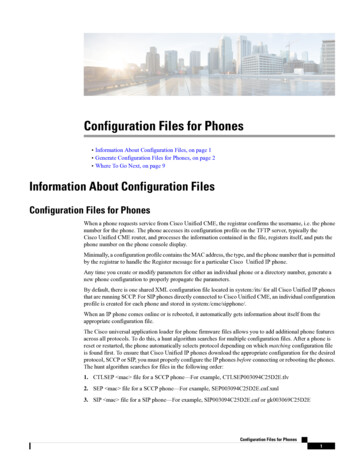
Transcription
Configuration Files for Phones Information About Configuration Files, on page 1 Generate Configuration Files for Phones, on page 2 Where To Go Next, on page 9Information About Configuration FilesConfiguration Files for PhonesWhen a phone requests service from Cisco Unified CME, the registrar confirms the username, i.e. the phonenumber for the phone. The phone accesses its configuration profile on the TFTP server, typically theCisco Unified CME router, and processes the information contained in the file, registers itself, and puts thephone number on the phone console display.Minimally, a configuration profile contains the MAC address, the type, and the phone number that is permittedby the registrar to handle the Register message for a particular Cisco Unified IP phone.Any time you create or modify parameters for either an individual phone or a directory number, generate anew phone configuration to properly propagate the parameters.By default, there is one shared XML configuration file located in system:/its/ for all Cisco Unified IP phonesthat are running SCCP. For SIP phones directly connected to Cisco Unified CME, an individual configurationprofile is created for each phone and stored in system:/cme/sipphone/.When an IP phone comes online or is rebooted, it automatically gets information about itself from theappropriate configuration file.The Cisco universal application loader for phone firmware files allows you to add additional phone featuresacross all protocols. To do this, a hunt algorithm searches for multiple configuration files. After a phone isreset or restarted, the phone automatically selects protocol depending on which matching configuration fileis found first. To ensure that Cisco Unified IP phones download the appropriate configuration for the desiredprotocol, SCCP or SIP, you must properly configure the IP phones before connecting or rebooting the phones.The hunt algorithm searches for files in the following order:1. CTLSEP mac file for a SCCP phone—For example, CTLSEP003094C25D2E.tlv2. SEP mac file for a SCCP phone—For example, SEP003094C25D2E.cnf.xml3. SIP mac file for a SIP phone—For example, SIP003094C25D2E.cnf or gk003069C25D2EConfiguration Files for Phones1
Configuration Files for PhonesPer-Phone Configuration Files4. XML default file for SCCP phones—For example, SEPDefault.cnf.xmls5. XML default file for SIP phones—For example, SIPDefault.cnfIn Cisco Unified CME 4.0 and later for SCCP and in Cisco CME 3.4 and later for SIP, you can designate oneof the following locations in which to store configuration files: System (Default)—For SCCP phones, one configuration file is created, stored, and used for all phonesin the system. For SIP phones, an individual configuration profile is created for each phone. Flash or slot 0—When flash or slot 0 memory on the router is the storage location, you can createadditional configuration files to be applied per phone type or per individual phone, such as user or networklocales. TFTP—When an external TFTP server is the storage location, you can create additional configurationfiles to be applied per phone type or per individual phone, which are required for multiple user andnetwork locales.Per-Phone Configuration FilesIf configurations files for SCCP phones are to be stored somewhere other than in the default location, thefollowing individual configuration files can be created for SCCP phones: Per phone type—Creates separate configuration files for each phone type and all phones of the sametype use the same configuration file. This method is not supported if the configuration files are to bestored in the system location. Per phone—Creates a separate configuration file for each phone, by MAC address. This method is notsupported if the configuration files are to be stored in the system location.For configuration information, see Define Per-Phone Configuration Files and Alternate Location for SCCPPhones.Generate Configuration Files for PhonesGenerate Configuration Files for SCCP PhonesTo generate the configuration profile files that are required by the SCCP phones in Cisco Unified CME andwrite them to either system memory or to the location specified by the cnf-file location command, follow thesteps in this section.Configuration Files for Phones2
Configuration Files for PhonesGenerate Configuration Files for SCCP PhonesRestriction Externally stored and per-phone configuration files are not supported on the Cisco Unified IP Phone7902G, 7910, 7910G, or 7920, or the Cisco Unified IP Conference Station 7935 and 7936. TFTP does not support file deletion. When configuration files are updated, they overwrite any existingconfiguration files with the same name. If you change the configuration file location, files are not deletedfrom the TFTP server. Generating configuration files on flash or slot 0 can take up to a minute, depending on the number offiles being generated. F or smaller routers such as Cisco 2600 series routers, you must manually enter the squeeze commandto erase files after changing the configuration file location or entering any commands that trigger thedeletion of configuration files. Unless you use the squeeze command, the space used by the moved ordeleted configuration files is not usable by other files.SUMMARY STEPS1.2.3.4.5.enableconfigure terminaltelephony-servicecreate cnf-filesendDETAILED STEPSStep 1Command or ActionPurposeenableEnables privileged EXEC mode.Example: Enter your password if prompted.Router enableStep 2configure terminalEnters global configuration mode.Example:Router# configure terminalStep 3telephony-serviceEnters telephony-service configuration mode.Example:Router(config)# telephony-serviceStep 4create cnf-filesBuilds the XML configuration files required for IP phones.Example:Router(config-telephony)# create cnf-filesStep 5endReturns to privileged EXEC mode.Example:Router(config-telephony)# endConfiguration Files for Phones3
Configuration Files for PhonesVerify Configuration Files for SCCP PhonesVerify Configuration Files for SCCP PhonesTo verify the Cisco Unified CME phone configuration, perform the following steps.Step 1show telephony-service allUse this command to verify the configuration for phones, directory numbers, voice ports, and dial peers inCisco Unified CME.Example:Router#show telephony-service allCONFIG (Version 4.0(0)) Version 4.0(0)Cisco Unified CallManager ExpressFor on-line documentation please /tsd products support series home.htmlip source-address 10.0.0.1 port 2000max-ephones 24max-dn 24dialplan-pattern 1 408734.voicemail 11111transfer-pattern 510734.keepalive 30ephone-dn 1number 5001huntstopephone-dn 2number 5002huntstopcall-forward noan 5001 timeout 8Step 2show telephony-service tftp-bindingsUse this command to display the current configuration files accessible to IP phones.Example:Router#show telephony-service ystem:/its/SEPDEFAULT.cnf alias SEPDefault.cnfsystem:/its/XMLDefault.cnf.xml alias stem:/its/XMLDefault7960.cnf.xml alias nt.xml alias German ionary.xml alias German 0-kate.xml alias German ionary.xml alias German 0-tones.xml alias Germany/7960-tones.xmlConfiguration Files for Phones4
Configuration Files for PhonesGenerate Configuration Profiles for SIP PhonesGenerate Configuration Profiles for SIP PhonesTo generate the configuration profile files that are required by the SIP phones in Cisco Unified CME andwrite them to the location specified by the tftp-path (voice register global) command, follow the steps inthis section.Any time you create or modify parameters under the voice register dn or voice register pool configurationmodes, generate a new configuration profile and properly propagate the parameters.CautionIf your Cisco Unified CME system supports SCCP and also SIP phones, do not connect your SIP phones tothe network until after you have verified the phone configuration profiles.Before you begin Cisco Unified CME 3.4 or a later version. The mode cme command must be enabled in Cisco Unified CME.SUMMARY STEPS1.2.3.4.5.6.enableconfigure terminalvoice register globalfile textcreate profileendDETAILED STEPSStep 1Command or ActionPurposeenableEnables privileged EXEC mode.Example: Enter your password if prompted.Router enableStep 2configure terminalEnters global configuration mode.Example:Router# configure terminalStep 3voice register globalExample:Enters voice register global configuration mode to setparameters for all supported SIP phones inCisco Unified CME.Router(config)# voice register globalStep 4file textExample:Router(config-register-global)# file text(Optional) Generates ASCII text files of the configurationprofiles generated for Cisco Unified IP Phone 7905s and7905Gs, Cisco Unified IP Phone 7912s and 7912Gs,Cisco ATA-186, or Cisco ATA-188.Configuration Files for Phones5
Configuration Files for PhonesVerify Configuration Profiles for SIP PhonesCommand or ActionPurpose Default—System generates binary files to save diskspace.Step 5Generates configuration profile files required for SIP phonesand writes the files to the location specified with tftp-pathcommand.create profileExample:Router(config-register-global;)# create profileStep 6Exits configuration mode and enters privileged EXEC mode.endExample:Router(config-register-global)# endVerify Configuration Profiles for SIP PhonesTo verify the configuration profiles, perform the following steps. SIP phones to be connected toCisco Unified CME can register and minimally, have an assigned phone number, only if the configuration iscorrect.Step 1show voice register tftp-bindUse this command to display a list of configuration profiles that are accessible to SIP phones using TFTP. The file nameincludes the MAC address for each SIP phone, such as SIP mac-address .cnf. Verify that a configuration profile isavailable for each SIP phone in Cisco Unified CME.The following is sample output from this p-serverStep 2show voice register tftp-bindSIPDefault.cnf url system:/cme/sipphone/SIPDefault.cnf syncinfo.xml url nf url F7932.cnf url DE0AA.cnf url 9012 url txt url system:/cme/sipphone/gk123456789012.txtshow voice register profileUse this command to display the contents of the ASCII format configuration profile for a particular voice register pool.To generate ASCII text files of the configuration profiles for Cisco Unified IP Phone 7905s and 7905Gs, CiscoUnified IP Phone 7912s and 7912Gs, Cisco ATA-186s, and Cisco ATA-188s, use the file text command.NoteExample:The following is sample output from this command displaying information in the configuration profile for voice registerpool 4.Router#show voice register profile text 4Pool Tag: 4# txtConfiguration Files for Phones6
Configuration Files for PhonesVerify Configuration Profiles for SIP PhonesAutoLookUp:0DirectoriesUrl:0 edTransfer:1BlindTransfer:1 .0.0.0UID:2468Step 3more systemUse this command to display the contents of the configuration profile for a particular Cisco Unified IP Phone 7940,Cisco Unified IP Phone 7905G, Cisco Unified IP Phone 7960, or Cisco Unified IP Phone 7960G.The following is sample output from this command displaying information in two SIP configuration profile files. TheSIPDefault.cnf configuration profile is a shared file and SIP MAC address .cnf is the SIP configuration profile forthe SIP phone with the designated MAC address.Router#more system:/cme/sipphone/SIPDefault.cnfimage version: "P0S3-07-4-00";proxy1 address: "10.1.18.100";proxy2 address: "";proxy3 address: "";proxy4 address: "";proxy5 address: "";proxy6 address: "";proxy1 port: "5060";proxy2 port: "";proxy3 port: "";proxy4 port: "";proxy5 port: "";proxy6 port: "";proxy register: "1";time zone: "EST";dst auto adjust: "1";dst start month: "April";dst start day: "";dst start day of week: "Sun";dst start week of month: "1";dst start time: "02:00";dst stop month: "October";dst stop day: "";dst stop day of week: "Sun";dst stop week of month: "8";dst stop time: "02:00";date format: "M/D/Y";time format 24hr: "0";local cfwd enable: "1";directory url: "";messages uri: "2000";services url: "";logo url: "";stutter msg waiting: "0";sync: "0000200155330856";telnet level: "1";autocomplete: "1";Configuration Files for Phones7
Configuration Files for PhonesVerify Configuration Profiles for SIP Phonescall stats: "0";Domain Name: "";dtmf avt payload: "101";dtmf db level: "3";dtmf inband: "1";dtmf outofband: "avt";dyn dns addr 1: "";dyn dns addr 2: "";dyn tftp addr: "";end media port: "32766";http proxy addr: "";http proxy port: "80";nat address: "";nat enable: "0";nat received processing: "0";network media type: "Auto";network port2 type: "Hub/Switch";outbound proxy: "";outbound proxy port: "5060";proxy backup: "";proxy backup port: "5060";proxy emergency: "";proxy emergency port: "5060";remote party id: "0";sip invite retx: "6";sip retx: "10";sntp mode: "directedbroadcast";sntp server: "0.0.0.0";start media port: "16384";tftp cfg dir: "";timer invite expires: "180";timer register delta: "5";timer register expires: "3600";timer t1: "500";timer t2: "4000";tos media: "5";voip control port: "5060";Router#more system:/cme/sipphone/SIP000CCE62BCED.cnfimage version: "P0S3-07-4-00";user info: "phone";line1 name: "1051";line1 displayname: "";line1 shortname: "";line1 authname: "1051";line1 password: "ww";line2 name: "";line2 displayname: "";line2 shortname: "";line2 authname: "";line2 password: "";auto answer: "0";speed line1: "";speed label1: "";speed line2: "";speed label2: "";speed line3: "";speed label3: "";speed line4: "";speed label4: "";speed line5: "";speed label5: "";call hold ringback: "0";Configuration Files for Phones8
Configuration Files for PhonesWhere To Go Nextdnd control: "0";anonymous call block: "0";callerid blocking: "0";enable vad: "0";semi attended transfer: "1";call waiting: "1";cfwd url: "";cnf join enable: "1";phone label: "";preferred codec: "g711ulaw";Where To Go NextAfter you generate a configuration file for a Cisco Unified IP phone connected to the Cisco Unified CMErouter, you are ready to download the file to the phone. See Reset and Restart Phones.Configuration Files for Phones9
Configuration Files for PhonesWhere To Go NextConfiguration Files for Phones10
otsupportedontheCiscoUnifiedIPPhone nceStation7935and7936.File Size: 1MBPage Count: 10
